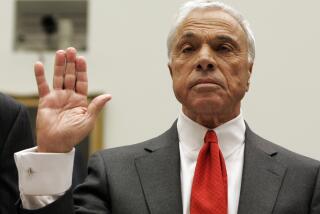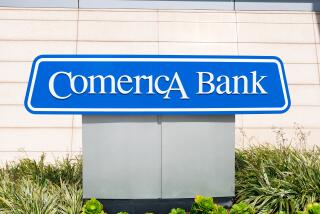S&Ls; Suffer $19.2-Billion Loss for Worst Year Ever
- Share via
WASHINGTON — Battered by losses in junk bonds and real estate, the savings and loan industry lost $6.5 billion in the fourth quarter and $19.2 billion for the year, both records, federal regulators reported Monday.
The massive losses were surprising, because officials had suggested previously that the industry had reached its low point, having already recorded huge write-downs on real estate and other assets.
Regulators also reported another ominous trend: Healthy S&Ls; as a group are making very little money. The 2,393 institutions currently considered safe from any government takeover had a net income of just $28 million, the Office of Thirft Supervision said.
“Industries that don’t make money shrink, and we will see shrinkage and the eventual merger of what is left into the banking industry,” said Robert Litan, an economist and S&L; expert with the Brookings Institution.
“The worst news is that the healthy part of the industry is barely making money; that’s just terrible,” he said. The profit margin of the industry is “totally inadequate” given the relatively high risks, he added.
The regulators’ report indicates the industry is rapidly breaking into three groups: insolvent institutions seized by the federal government and continuing to bleed red ink, weak ones likely to fall into government control later and a comparatively healthy cadre of survivors.
The quarterly losses were greater than expected because of write-downs on junk bonds and a persistent slump in real estate markets in the Southwest and Colorado.
The losses will drive up the eventual bill for closing or selling hundreds of financially sick S&Ls; and paying off the depositors, whose accounts are insured up to $100,000. The clean-up of the S&L; industry is currently projected to cost $285 billion over the next 30 years. But if many more institutions fail and must be seized by the government, the price tag will rise considerably.
“You never know how much the cost will be to the taxpayers until you liquidate institutions or sell assets,” said James Freund, acting chief economist for the Office of Thrift Supervision, which regulates S&Ls.;
Litan expects only half the institutions operating outside government control to survive as independent S&Ls.; S&Ls; in markets with continuing strong mortgage demand, such as California, will remain in business, along with those that do a good job of controlling costs, according to Litan. Meanwhile, banks surpassed S&Ls; last year as the biggest originator of home mortgages, according to Litan.
The overall loss of $6.5 billion for the nation’s 2,878 thrifts rose from a third-quarter deficit of $5 billion. The year’s loss of $19.2 billion climbed substantially from the loss of $13.4 billion in 1988.
Thrifts are being forced to set aside large sums of money to cover potential losses from depressed real estate. Institutions also are marking down the value of their junk bonds to the true market price, instead of the initial purchase value carried on the books.
“Much of the loss is due to the recognition of bad assets,” said Freund.
The federal government has seized the sickest thrifts, taking control of 402 institutions in the past 14 months. The Office of Thrift Supervision is “carrying out (Congress’) mandate of weeding out the insolvent and unsalvageable institutions that are compiling the big losses, and transferring them to the Resolution Trust Corp.’s control for eventual sale or liquidation,” Freund said.
The S&Ls; under government control suffered total losses of $6.2 billion during the fourth quarter. The overall deficit figure reflects both write-downs in the value of assets and continuing losses from daily operations. S&Ls; under government control lost money from regular operations at a rate of $26 million a day during the last quarter of the year.
The 32 savings and loans based in Orange County at the end of the year are headed toward a record loss as well, based on the $769.4 million in red ink they compiled for the first three quarters. Annual results were not available on Monday.
But if the county’s thrifts shatter their combined $920-million loss of two years ago, one institution--Lincoln Savings & Loan--will be the primary cause. Lincoln lost $877.2 million in the first nine months and is expected to become one of the nation’s costliest bailouts.
In addition to the seized S&Ls;, weak institutions targeted as possible future takeover candidates had losses of $324 million.
The government’s ability to recover a significant sum of money will depend on its success in selling real estate assets from defunct S&Ls.; The government will hold the biggest real estate auction in history this summer, offering a $200-million portfolio of properties, including office buildings, condominiums, and shopping centers.
L. William Seidman, the chief federal regulator in charge of the S&L; clean-up, told the House Banking Committee on Monday that the failure of CenTrust Savings Bank in Miami could cost the government $2 billion. CenTrust would become the second most costly S&L; collapse, ranking behind Lincoln Savings & Loan of Irvine, which is expected to cost $2.5 billion.
CenTrust was seized by regulators earlier this month. In December, Florida banking officials ordered the removal of David Paul as chairman and chief executive officer. Regulators offered a portrait of Paul’s opulent life style, largely financed by the S&L.;
THE S&L; INDUSTRY’S RED INK
Here is a list of savings institution profits or losses during the 1980s, according to the Office of Thrift Supervision.
1989: $19.2-billion loss 1988: $13.4-billion loss 1987: $7.8-billion loss 1986: $131-million profit 1985: $3.7-billion profit 1984: $1-billion profit 1983: $1.9-billion profit 1982: $4.1-billion loss 1981: $4.6-billion loss 1980: $800-million profit Source: Associated Press
Times staff writer James S. Granelli contributed to this report.
More to Read
Inside the business of entertainment
The Wide Shot brings you news, analysis and insights on everything from streaming wars to production — and what it all means for the future.
You may occasionally receive promotional content from the Los Angeles Times.










